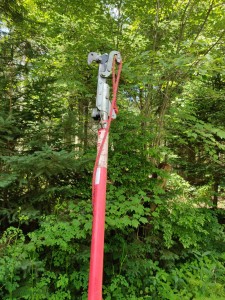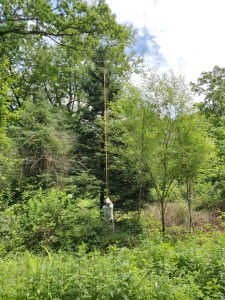Picture this: you’re out in the woods. You find a maple tree. It’s a species you can confidently identify, it’s not too far from the path, and it has clean, healthy leaves. Or in other words, it’s perfect for clipping off a branch for leaf samples. There’s just one problem… all the branches are at least 10 feet off the ground.
This dilemma is pretty frequent in my line of field work. Trees are tall. No shit, Sherlock, you’re probably thinking. And, like, I’m aware that, intellectually, we all know that trees are tall. But this knowledge doesn’t really hit on a physical level until you’re standing at the base of a huge oak, staring up at branches that you’d never be able to reach even if you were a champion high jumper. And that’s just the lowest branches! The peaks of some older trees at Black Rock Forest are hundreds of feet in the air. Walking on forest trails sometimes feels like walking through New York City, except much cleaner and quieter – I’m always looking up.

My good good pole saw
There is an easy solution to this dilemma, however. To collect leaves from above my arms’ length, Black Rock Forest has kindly allowed me to borrow a pole saw during my weeks here. A pole saw, as I’ve described in previous posts, is basically a long saw on the end of a pole. Gardeners use it for pruning trees and large shrubs, and plant biologists use it for collecting leaf samples from branches too high for them to reach on their own.
My best friend pole saw (as I’ve affectionately taken to calling her) is a fairly simple model. She’s about six feet long in its usual state, and extends to twelve feet when I pull out the extendable piece. When I lift the instrument into the air, my own height adds on a couple more feet; thus, with the saw, my range is a total of about fifteen feet. That’s over double the height I could reach on my own.
To operate my pole saw, I stand directly beneath a branch I’d like to cut and position the pole perpendicular to that branch. I adjust the pole until the saw part (mounted on top) is settled around the branch. Then, I pull down on the rope attached to the saw, causing it to swing down and chop the branch off. It’s basically thrusting a knife into the air, positioning it in a specific spot, and then pulling it down to cut. The technique takes a good sense of balance (which I don’t have) and a whole lot of patience (which I definitely don’t have), but I’m getting better with practice!
It’s impossible to fully capture this technique with a written description, but I think this video might help you get a better idea:
(Big thanks to Ellery for taking this video!)
I’m also getting pretty attached to this pole saw, as you might be able to tell by the story I told at the beginning of the video. Not only is she an invaluable tool in my field work, she’s also a companion on my long hikes through the forest. The saw doubles as a walking stick, an instrument for testing whether the ground ahead of me is stable, and an imaginary conversation partner. I’ve gotten into the habit of apologizing to her when I lose balance and let the pole swing out abruptly or let the blade hit the ground.

My research mentor operating a 30 foot pole saw
My pole saw is a good friend. She may not be as tall or as sturdy as other pole saws, and she may not be able to reach high branches like a lift truck or the shotgun method (topics for future posts.) She may be difficult to balance, and she might get heavy on long walks, and she might sometimes get stuck in a spruce tree and give me ten minutes of extreme stress. But she’s always ready for an adventure – and what more could you ask from a friend?
Photos and video via Betsy Ladyzhets

Great description! Enjoyed reading! Good luck getting more leaf samples with your trusty friend!
LikeLike